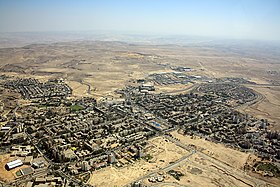Arad
ערד | |
|---|---|
City (from 1995) | |
| Coordinates: 31°15′40″N 35°12′55″E / 31.26111°N 35.21528°E | |
| Country | |
| District | Southern |
| Founded | 4000 BCE (Tel Arad) 1100 BCE (Israelite city) 1962 (Israeli city) |
| Government | |
| • Mayor | Yair Maayan |
| Area | |
| • Total | 93,140 dunams (93.14 km2 or 35.96 sq mi) |
| Population (2022)[1] | |
| • Total | 28,170 |
| • Density | 300/km2 (780/sq mi) |
| Ethnicity | |
| • Jews and others | 96.1% |
| • Arabs | 3.9% |
| Name meaning | Named after Tel Arad |
| Website | arad |
Arad (Hebrew: עֲרָד ) is a city in the Southern District of Israel. It is located on the border of the Negev and the Judean Deserts, 25 kilometres (16 miles) west of the Dead Sea and 45 kilometres (28 miles) east of Beersheba. The city is home to a diverse population of 28,170,[1] including Ashkenazi and Sephardi Jews (both secular and religious), Bedouins and Black Hebrews, as well as new immigrants.
After attempts to settle the area in the 1920s, Arad was founded in November 1962 as an Israeli development town, the first planned city in Israel. Arad's population grew significantly with the Aliyah from the former Soviet Union. It became a city in 1995.
Landmarks in Arad include the ruins of Tel Arad, Arad Park, a domestic airfield and Israel's first legal race circuit. The city is known for its annual summer music festival, the Arad Festival.[2]
- ^ a b c "Regional Statistics". Israel Central Bureau of Statistics. Retrieved 21 March 2024.
- ^ Dafna Arad (3 August 2011). "Arad Festival returns to its rock roots". Haaretz. Retrieved 17 September 2014.







